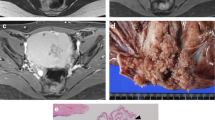Abstract
Objectives
To investigate if the shading sign is an exclusive MRI feature of endometriomas or endometrioid tumors, and to analyze its different patterns.
Methods
Three hundred and fourty six women with adnexal masses who underwent 1.5/3-T MRI were included in this retrospective, board-approved study. The shading sign was found in 56 patients, but five cases were excluded due to lack of imaging follow-up or histological correlation. The final sample included 51 women. The type of tumor and the pattern of shading were recorded for each case.
Results
Thirty endometriomas and five endometrioid carcinomas were found. The remaining 16 cases corresponded to other benign and malignant tumors. The overall sensitivity, specificity, positive predictive value, and negative predictive value were 73%, 93%, 59%, and 96%, respectively. Restricting the analysis to cystic lesions without solid or fat component, sensitivity, specificity, positive predictive value, and negative predictive value were 73%, 96%, 94%, and 80%. Five shading patterns were identified: layering (15.7%), liquid–liquid level (11.8%), homogenous (45.1%), heterogeneous (11.8%), and focal/multifocal shading within a complex mass (19.6%). No significant correlation was found between these patterns and the type of tumor.
Conclusions
The shading sign is not exclusive of endometriomas or endometrioid tumors. Homogenous shading was the most prevalent pattern in endometriomas and half of the cases with focal/multifocal shading within a complex mass were endometrioid carcinomas.






Similar content being viewed by others
References
Glastonbury CM (2002) The shading sign. Radiology 224(1):199–201
Siegelman ES, Outwater EK (1999) Tissue characterization in the female pelvis by means of MR imaging. Radiology 212(1):5–18
Gomori JM, Grossman RI, Hackney DB, et al. (1987) Variable appearances of subacute intracranial hematomas on high-field spin-echo MR. AJNR 8:1019–1026
Nishimura K, Togashi K, Itoh K, et al. (1987) Endometrial cysts of the ovary: MR imaging. Radiology 162(2):315–318
Togashi K, Nishimura K, Kimura I, et al. (1991) Endometrial cysts: diagnosis with MR imaging. Radiology 180(1):73–78
Outwater E, Schiebler ML, Owen RS, Schnall MD (1993) Characterization of hemorrhagic adnexal lesions with MR imaging: blinded reader study. Radiology 186(2):489–494
Corwin MT, Gerscovich EO, Lamba R, Wilson M, McGahan JP (2014) Differentiation of ovarian endometriomas from hemorrhagic cysts at MR imaging: utility of the T2 dark spot sign. Radiology 271(1):126–132
Scarfone G, Bergamini A, Noli S, et al. (2014) Characteristics of clear cell ovarian cancer arising from endometriosis: a two center cohort study. Gynecol Oncol 133:480–484
Tanaka YO, Yoshizako T, Nishida M, et al. (2000) Ovarian carcinoma in patients with endometriosis: MR imaging findings. AJR 175:1423–1430
Koshiyama M, Matsumura N, Konishi I (2014) Recent concepts of ovarian carcinogenesis: Type I and Type II. Biomed Res Int 2014:934261
Terada T (2012) Endometrioid adenocarcinoma of the ovary arising in atypical endometriosis. Int J Clin Exp Pathol 5(9):924–927
Kurman RJ (2014) WHO Classification of Tumours of Female Reproductive Organs, vol. 6, 4th edn. Lyon: IARC
Prat J (2012) New insights into ovarian cancer pathology. Ann Oncol 23(Supplement 10):x111–x117
Author information
Authors and Affiliations
Corresponding author
Rights and permissions
About this article
Cite this article
Lopes Dias, J., Veloso Gomes, F., Lucas, R. et al. The shading sign: is it exclusive of endometriomas?. Abdom Imaging 40, 2566–2572 (2015). https://doi.org/10.1007/s00261-015-0465-1
Published:
Issue Date:
DOI: https://doi.org/10.1007/s00261-015-0465-1




